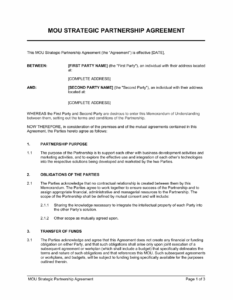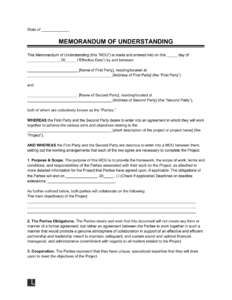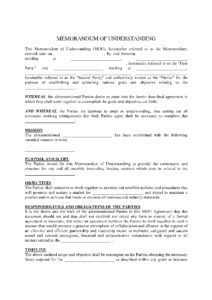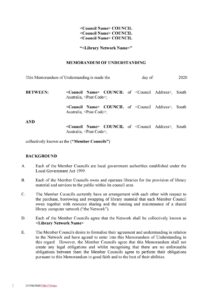Embarking on an acquisition journey is a significant step for any business, filled with intricate details, legal considerations, and strategic decisions. Before diving deep into definitive legal agreements, there’s often a crucial preliminary stage where both parties need to align their understanding and intentions. This is where a Memorandum of Understanding, or MOU, steps in as a vital foundational document, providing a structured yet flexible framework for these initial discussions.
Think of it as setting the stage for a complex play; you wouldn’t jump straight to the final act without first agreeing on the plot, characters, and overall vision. Similarly, in an acquisition, an MOU helps outline the fundamental terms and expectations without creating binding obligations on the main deal points. Having a well-crafted memorandum of understanding acquisition template can dramatically streamline this preliminary phase, ensuring both buyer and seller are on the same page regarding the path forward.
Why an MOU is Your Acquisition’s Best Friend
An acquisition Memorandum of Understanding (MOU) serves as a declaration of intent between the potential buyer and seller, signaling their mutual desire to pursue a transaction. While generally non-binding regarding the ultimate sale, it establishes a framework for how the parties will proceed, outlining preliminary terms and conditions. It’s not the final contract, but rather a handshake on paper that guides the subsequent, more detailed negotiations and due diligence processes. It lays out the agreed-upon roadmap, giving both sides a clear vision of the journey ahead.
The primary purpose of an MOU in an acquisition is to build trust and ensure clarity early in the process. It helps to identify potential deal-breakers upfront, saving both parties significant time and legal expenses that would otherwise be spent on definitive agreements. By committing these preliminary understandings to writing, the MOU acts as a safeguard against misunderstandings and mismatched expectations, fostering an environment of transparency as the deal progresses. It’s about getting everyone aligned on the core principles before investing heavily in legal and financial resources.
Typically, an acquisition MOU will touch upon several key elements that are essential for moving forward. These often include the identification of the parties involved, a high-level description of the assets or shares to be acquired, an estimated purchase price or valuation range, and the proposed timeline for due diligence. It also usually covers confidentiality clauses, an exclusivity period during which the seller cannot negotiate with other potential buyers, and provisions for governing law. These elements, though preliminary, establish critical boundaries and expectations for the deal.
Utilizing a structured memorandum of understanding acquisition template offers substantial benefits. It ensures that no critical preliminary aspect is overlooked, providing a consistent format for negotiations. This systematic approach reduces ambiguity, expedites the initial stages of a complex acquisition, and ultimately paves the way for a smoother transition to a definitive purchase agreement. It’s about being prepared and professional from the very first step.
Key Components You’ll Find
- Identification of Parties: Clearly stating who the buyer and seller are.
- Acquisition Structure Outline: A high-level view of how the deal might be structured (e.g., asset purchase, share purchase).
- Preliminary Valuation or Price Range: An indicative value to guide discussions.
- Due Diligence Process: The scope and timeline for the buyer’s review of the seller’s business.
- Exclusivity Period: A timeframe during which the seller agrees not to solicit or entertain other offers.
- Confidentiality Clauses: Protecting sensitive information shared during discussions.
- Governing Law: Specifying the jurisdiction whose laws will govern the MOU.
Crafting Your Memorandum of Understanding for a Smooth Acquisition
When it comes to drafting your specific MOU, customization is absolutely key. While a memorandum of understanding acquisition template provides an excellent starting point, it’s crucial to tailor every section to the unique circumstances of your transaction. Consider the specific assets involved, the strategic goals of both parties, and any particular sensitivities or requirements that need to be addressed. A generic template is a guide, but your specific MOU should reflect the nuances of your unique deal, ensuring maximum clarity and relevance.
Even though much of an MOU is non-binding, the process of drafting and negotiating it is inherently collaborative. It’s an opportunity for both buyer and seller to articulate their expectations, discuss potential challenges, and agree upon a shared vision for the acquisition. This dialogue is invaluable, as it helps to build rapport and uncover any major discrepancies in understanding before significant resources are committed. A well-negotiated MOU reflects a mutual commitment to explore the acquisition in good faith.
It’s important to remember that while the core acquisition terms outlined in an MOU are typically non-binding, certain provisions, such as confidentiality and exclusivity clauses, are often intended to be legally enforceable. For this reason, always involve legal counsel early in the process. A lawyer can ensure that the template is adapted correctly, that any binding clauses are properly drafted, and that the entire document aligns with your strategic objectives and protects your interests. Professional advice is indispensable, safeguarding your position as you move towards a definitive agreement.
Starting an acquisition with a clear, mutually understood framework sets a positive tone and streamlines the entire process. It minimizes ambiguity, fosters trust, and provides a solid foundation upon which more complex legal agreements can be built. By taking the time to properly outline intentions in this preliminary document, both parties can navigate the intricate path of an acquisition with greater confidence and efficiency. This initial alignment proves invaluable, paving the way for a more organized and ultimately successful transaction.



